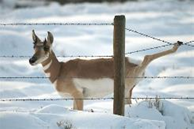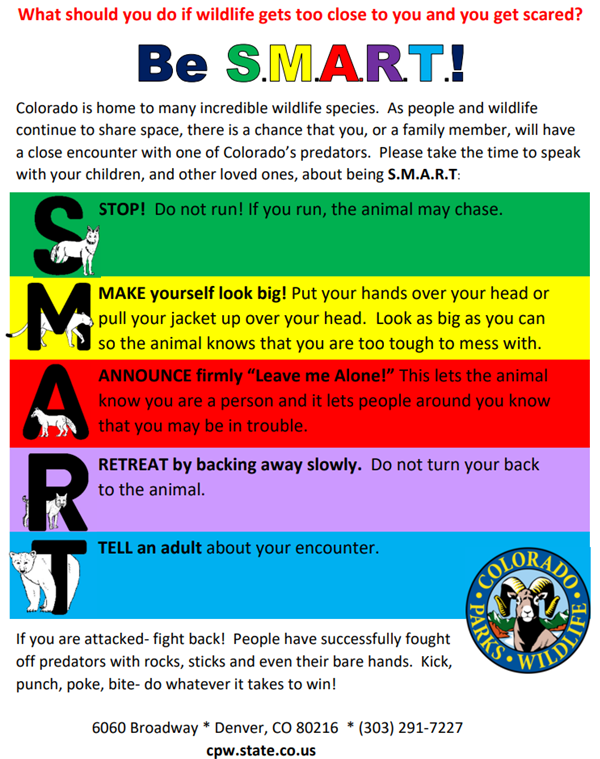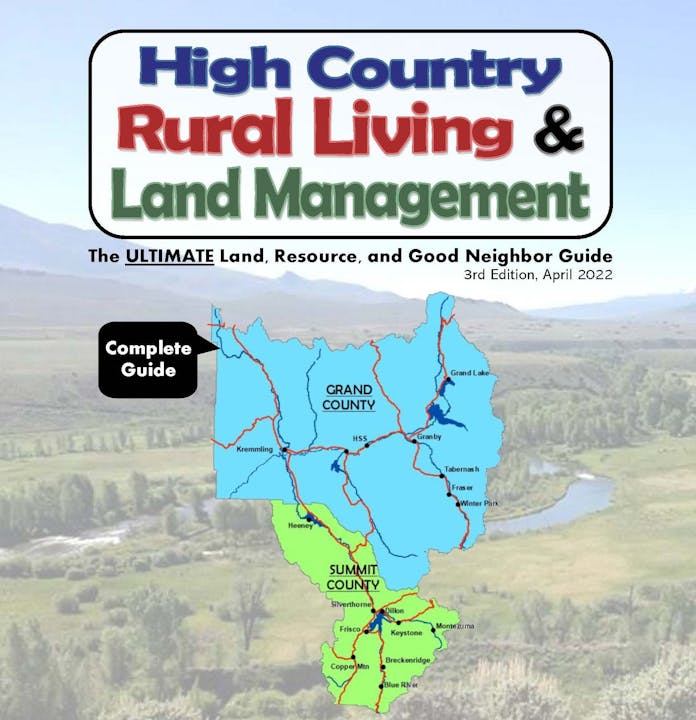Enjoying Our Wildlife

ON THIS PAGE
- Do's Around Wildlife
- Dont's Around Wildlife
- Creating Wildlife Habitat
- Fencing for Wildlife
The mountains of Colorado are known for their abundant and diverse wildlife. Wildlife traditionally lived in the rugged backcountry, but we are now seeing them venture into more populated areas as people encroach on their historic habitat. Because people continue to explore the wilds of Colorado, incidences of negative animal encounters and displaced wildlife continue to grow. Observing wildlife is fascinating, but there are definite Do’s and Don’ts when wildlife viewing to keep both people and wildlife safe. Contact Colorado Parks & Wildlife about wildlife-related questions.
DO’S Around Wildlife

- Observe wildlife from a distance
- Take a photo and observe for only a short time period before moving on
- Clean up all trash and bring indoors or place in bear-safe trashcans and dumpsters (away from your tent if camping)
- Clean up grease from your barbeque grill so as to NOT attract bears, foxes, and other wildlife to the party
- Feed pets inside
- Create quality wildlife habitat on your land
- Check out this link for ways to Minimize Impacts on Wintering Wildlife
DON’TS Around Wildlife
- Do NOT harass, try to capture, or get too close to wildlife. It can very distressing and harmful to the animals.
- Do NOT observe wildlife for too long (especially if you are close to them). Your extended presence could cause distress to the animal and disrupt its natural behavior. Each season presents a different kind of stress to wildlife. Fall is mating season; winter brings a lack of available food; and spring and summer are birthing seasons.
- Do NOT feed or bait wildlife. Feeding wildlife causes major problems and is often ILLEGAL. It can also be harmful to big game such as deer, elk, and bears. If wildlife become dependent on unnatural food sources found in landscaping, crops, or unnatural feeds, they can lose their ability to forage on their own. Feeding of wildlife can also cause animals to congregate, create traffic hazards, draw them away from their historic winter ranges, prevent migration, and transmit diseases. Placing salt blocks around your property specifically for wildlife is considering feeding and baiting. Thus, it is ILLEGAL. While it is not illegal to have bird feeders on your property, please realize that bird feeders can also attract other (not so cute and feathery) wildlife. It is best to hang feeders in areas that other wildlife CANNOT reach (on a wire between two trees or in an area where you can remove and bring the feeder in at night).
- Do NOT let your dogs and cats chase (or get too close to) wildlife. Dogs are a year-round threat to wildlife. Dogs, even the sweetest and most gentle, find it fun to chase wildlife. This causes unwarranted stress and can result in wildlife getting caught in fences, hit on the road, or expending critical energy reserves needed to survive. Additionally, evidence suggests that domestic cats kill millions of songbirds annually. There are laws protecting wildlife, so keep your cats and dogs contained or leashed to prevent chasing of wildlife.
- Do NOT fish when it is HOT outside. We have cold water fisheries in Middle Park, meaning that our fish thrive best in cold waters (<65°F). When we have extended periods of hot weather in the summertime, temperatures in our streams and rivers can rise above the ideal temperature for our cold water trout. This causes immense stress and can be fatal. It is best for humans to put the fishing poles away during hot periods of the day.
- Do NOT Shed Hunt during the winter. Deer, elk, and moose all have antlers. Antlers, unlike horns, are ‘shed’ every year. Shed hunting is legal and does not cost a thing, but it is PROHIBITED on public lands west of I-25 (including Grand and Summit Counties) from January 1st thru April 30th each year. Though restrictions do not affect private lands, landowners should limit shed hunting when big game are present. For more info on shed hunting, visit: Shed Antler and Horn Collection | Colorado Parks and Wildlife.
See Colorado Revised Statutes Title 33, Article 6 for details on Law Enforcement and Penalties related to wildlife infractions.
Creating Wildlife Habitat
Despite all the “Don’ts” of wildlife viewing found on the previous page, there are still actions you can take to improve the wildlife habitat value of your land. By improving its habitat value, you may see increased incidence of wildlife on and around your property. Suitable wildlife habitat has three components:
Food, Water, and Shelter
Just like humans, wildlife need to eat, drink, and have access to shelter. By increasing the diversity and abundance of vegetation (for food and shelter) and expanding the availability of water on your property (if legal and feasible), you may see more wild critters running around.
The Natural Resources Conservation Service (NRCS) has a Wildlife Habitat Backyard Conservation Tip Sheet with good information on creating wildlife habitat. Check it out at https://www.nrcs.usda.gov/wps/portal/nrcs/detail/national/home/?cid=nrcs143_023553
Fencing for Wildlife
We live most of our lives between post, rail, chain link, and wire. It’s difficult to imagine neighborhoods, farms, industry, and ranches without fences. They define property lines, confine pets and livestock, and protect the things most dear to our hearts. For humans, fences make “space” into “place.” For wildlife, fences limit travel and access to critical habitat.
Colorado Parks and Wildlife’s “Fencing with Wildlife in Mind” publication provides guidelines on constructing fences with wildlife in mind: https://cpw.state.co.us/Documents/LandWater/PrivateLandPrograms/FencingWithWildlifeInMind.pdf
| PROBLEM FENCES ARE: | FRIENDLY FENCES ARE: |
|---|---|
| Too high to jump over or too low to crawl under | Highly visible and allow animals to easily jump over or go under |
| Have loose wires | Fencing wire is placed on the side of the fence posts where the livestock is located |
| Have wires spaced too closely together | Smooth wire is found on the top and on the bottom strands |
| Lack visibility for fleeing animals | Top wire has a height of 42” |
| Create a complete barrier | There is at least 12” between the top two wires |
| There is at least 16” between the ground and the bottom wire | |
| For sheep and goats, is it recommended that the top wire be lower with less distance between the top two wires, and the bottom wire be 10” off the ground. |
Colorado Parks and Wildlife’s Habitat Partnership Program (HPP), funded by revenue from the sale of big game licenses, works through local committees to develop partnerships among landowners, land managers, sportspersons, the public and Colorado Parks and Wildlife (CPW) to reduce conflicts caused by deer, elk, pronghorn and moose to agriculture. Potential agricultural landowner projects include seeding, fencing, weed management, spring developments & more. For more information, contact Middle Park HPP (CPW), 970-725-6200, https://cpw.state.co.us/aboutus/Pages/HabitatPartnershipProgram.aspx
While research on the use and viability of Virtual Fencing (“Vencing”) for livestock in the high country continues, this is a potential wildlife friendly fencing option to keep in mind for the future.
More wildlife resources at http://www.middleparkcd.com/wildlife/, Hot Sulphur Springs CPW Office | 970-725-6200
References: 1, 8, 10, 33, 34, 35, 36, 78



